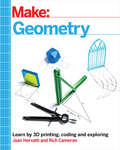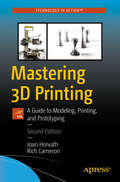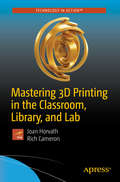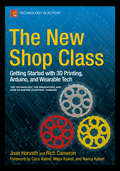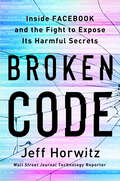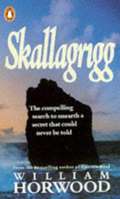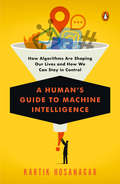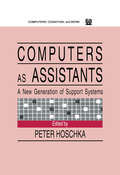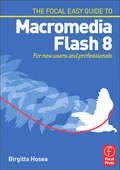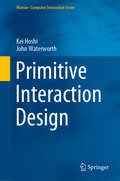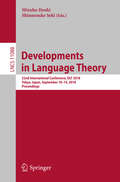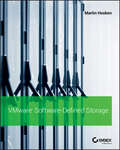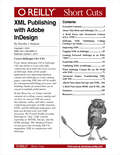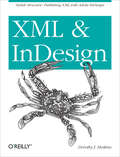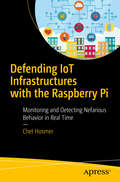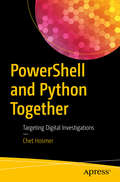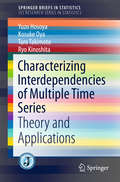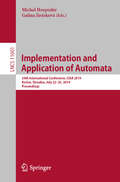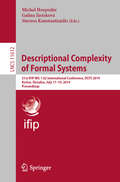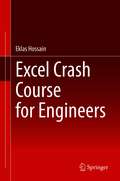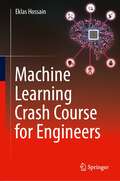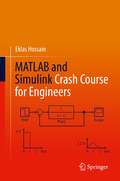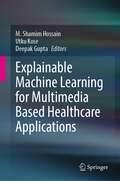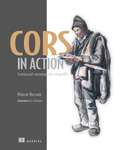- Table View
- List View
Make: Geometry
by Joan Horvath Rich CameronGeometry, of all the branches of mathematics, is the one that is most easily visualized by making something. However, it is all too easy to reduce it to reams of formulas to memorize and proofs to replicate. This book aims to take geometry back to its practical roots with 3D printed models and puzzles as well as demonstrations with household objects like flashlights and paper towel tubes.This is not a traditional geometry textbook, but rather builds up understanding of geometry concepts while also bringing in elements of concepts normally learned much later. Some of the models are counterintuitive, and figuring out how and why they work will both entertain and give insights. Two final chapters suggesting open-ended projects in astronomy and physics, and art and architecture, allow for deeper understanding and integration of the learning in the rest of the book.
Mastering 3D Printing: A Guide to Modeling, Printing, and Prototyping
by Joan Horvath Rich CameronGet the most out of your printer, including how to design models, choose materials, work with different printers, and integrate 3D printing with traditional prototyping to make techniques like sand casting more efficient.This book is for new 3D printer owners, makers of all kinds, entrepreneurs, technology educators, and anyone curious about what you can do with a 3D printer.In this revised and expanded new edition of Mastering 3D Printing, which has been a trusted resource through five years of evolution in the 3D printing industry, you’ll gain a comprehensive understanding of 3D printing. This book presumes no foreknowledge and describes what you need to know about how printers work, how to decide which type of printer (filament, resin, or powder) makes the most sense for you, and then how to go forward in the case of filament and resin printers. This new edition now includes material about consumer resin printing, the evolution of lower-cost metal printing, and the plethora of both materials and applications.What You’ll LearnChoose among the different 3D printing technologiesCreate or find 3D models to printMake both easy and challenging prints come out as you imaginedAssess whether your business, factory, home or classroom will benefit from 3D printingWork with applications that are good candidates for first projects in home and industrial applicationsWho This Book Is ForPeople who are encountering 3D printing for the first time, or for those who want to level up their skills. It is designed for the nontechnical adult and minimizes jargon. However more sophisticated users will still find tips and insights of value.
Mastering 3D Printing in the Classroom, Library, and Lab
by Joan Horvath Rich CameronLearn how to manage and integrate the technology of 3D printers in the classroom, library, and lab. With this book, the authors give practical, lessons-learned advice about the nuts and bolts of what happens when you mix 3D printers, teachers, students, and the general public in environments ranging from K-12 and university classrooms to libraries, museums, and after-school community programs.Take your existing programs to the next level with Mastering 3D Printing in the Classroom, Library, and Lab. Organized in a way that is readable and easy to understand, this book is your guide to the many technology options available now in both software and hardware, as well as a compendium of practical use cases and a discussion of how to create experiences that will align with curriculum standards. You'll examine the whole range of working with a 3D printer, from purchase decision to curriculum design. Finally this book points you forward to the digital-fabrication future current students will face, discussing how key skills can be taught as cost-effectively as possible.What You’ll LearnDiscover what is really involved with using a 3D printer in a classroom, library, lab, or public spaceReview use cases of 3D printers designed to enhance student learning and to make practical parts, from elementary school through university research labLook at career-planning directions in the emerging digital fabrication arenaWork with updated tools, hardware, and software for 3D printingWho This Book Is ForEducators of all levels, both formal (classroom) and informal (after-school programs, libraries, museums).
The New Shop Class
by Joan Horvath Rich CameronThe New Shop Class connects the worlds of the maker and hacker with that of the scientist and engineer. If you are a parent or educator or a budding maker yourself, and you feel overwhelmed with all of the possible technologies, this book will get you started with clear discussions of what open source technologies like 3D printers, Arduinos, robots and wearable tech can really do in the right hands. Written by real "rocket scientist" Joan Horvath, author of Mastering 3D Printing, and 3D printing expert Rich Cameron (AKA whosawhatsis), The New Shop Class is a friendly, down-to-earth chat about how hands-on making things can lead to a science career. Get practical suggestions about how to use technologies like 3D printing, Arduino, and simple electronics Learn how to stay a step ahead of the young makers in your life and how to encourage them in maker activities Discover how engineers and scientists got their start, and how their mindsets mirror that of the maker What you'll learn What all of the big "maker" technologies are, what they can do, and how to get more information Why scientists, citizen scientists, and makers do what they do -- and how they do what they do Why breaking things is as important as making things How portrayals of science differ from the real world How to encourage the young scientists and makers in your life, or become one yourself What scientists and makers can learn from each other Who this book is for Aspiring scientists, makers, teachers, students, and anyone who wants a guide to the vast and expanding world of makers and their tools and inventions. Table of Contents Front Matter: Featuring a Foreword by Coco Kaleel, Mosa Kaleel, and Nancy Kaleel Part 1. The Technologies Chapter 1. 21st Century Shop Teacher Chapter 2. Arduino, Raspberry Pi, and Programming Physical Things Chapter 3. 3D Printing Chapter 4. Robots, Drones, and Other Things that Move Part 2. Applications and Communities Chapter 5. Makerspaces and Hackerspaces Chapter 6. Citizen Science and Open Source Labs Chapter 7. Cosplay, Wearable Tech and the Internet of Things Chapter 8. Circuits and Programming for Kids Chapter 9. Open Source Mindset and Community Chapter 10. Creating Female Makers Chapter 11. Making at a Community College and Beyond Part 3. How Scientists Get Started Chapter 12. Becoming a Scientist Chapter 13. How Do Scientists Think? Chapter 14. What Do Scientists Do All Day? Part 4. Tying It All Together Chapter 15. Learning by Iterating Chapter 16. Learning Science by Making Chapter 17. What Scientists Can Learn from Makers Appendix: Links
Broken Code: Inside Facebook and the Fight to Expose Its Harmful Secrets
by Jeff HorwitzBy an award-winning technology reporter for The Wall Street Journal, a behind-the-scenes look at the manipulative tactics Facebook used to grow its business, how it distorted the way we connect online, and the company insiders who found the courage to speak out"Broken Code fillets Facebook&’s strategic failures to address its part in the spread of disinformation, political fracturing and even genocide. The book is stuffed with eye-popping, sometimes Orwellian statistics and anecdotes that could have come only from the inside." —New York Times Book ReviewOnce the unrivaled titan of social media, Facebook held a singular place in culture and politics. Along with its sister platforms Instagram and WhatsApp, it was a daily destination for billions of users around the world. Inside and outside the company, Facebook extolled its products as bringing people closer together and giving them voice.But in the wake of the 2016 election, even some of the company&’s own senior executives came to consider those claims pollyannaish and simplistic. As a succession of scandals rocked Facebook, they—and the world—had to ask whether the company could control, or even understood, its own platforms.Facebook employees set to work in pursuit of answers. They discovered problems that ran far deeper than politics. Facebook was peddling and amplifying anger, looking the other way at human trafficking, enabling drug cartels and authoritarians, allowing VIP users to break the platform&’s supposedly inviolable rules. They even raised concerns about whether the product was safe for teens. Facebook was distorting behavior in ways no one inside or outside the company understood. Enduring personal trauma and professional setbacks, employees successfully identified the root causes of Facebook's viral harms and drew up concrete plans to address them. But the costs of fixing the platform—often measured in tenths of a percent of user engagement—were higher than Facebook's leadership was willing to pay. With their work consistently delayed, watered down, or stifled, those who best understood Facebook&’s damaging effect on users were left with a choice: to keep silent or go against their employer.Broken Code tells the story of these employees and their explosive discoveries. Expanding on &“The Facebook Files,&” his blockbuster, award-winning series for The Wall Street Journal, reporter Jeff Horwitz lays out in sobering detail not just the architecture of Facebook&’s failures, but what the company knew (and often disregarded) about its societal impact. In 2021, the company would rebrand itself Meta, promoting a techno-utopian wonderland. But as Broken Code shows, the problems spawned around the globe by social media can&’t be resolved by strapping on a headset.
Skallagrigg
by William HorwoodThis story takes place in England, spanning the late 1800s to the not-too-distant future. One layer is the search for the "Skallagrigg", a mythical being known only to institutionalized disabled people. Are Arthur, a lttle boy with cerebral palsy who was left in a grim asylum, and the Skallagrigg merely myth? Read and find out. And then there's Esther Marquand, many years later, who as a woman with spastic cerebral palsy, cannot talk nor move much on her own. Yet she learns computers and writes amazing programming. SDhe goers in search of the Skallagrigg and makes her search into a computer game. Then there are all the other characters, including Tom, the close friend with Downs Syndrome. There are romances and losses. Surprises. Tears of sadness and joy. This is a good clean copy, I have verified accuracy with another person against the print book, but I'm not sure how screenreaders will come through on some of the phonetic disabled speech.
A Human's Guide to Machine Intelligence: How Algorithms Are Shaping Our Lives and How We Can Stay in Control
by Kartik HosanagarA Wharton professor and tech entrepreneur examines how algorithms and artificial intelligence are starting to run every aspect of our lives, and how we can shape the way they impact usThrough the technology embedded in almost every major tech platform and every web-enabled device, algorithms and the artificial intelligence that underlies them make a staggering number of everyday decisions for us, from what products we buy, to where we decide to eat, to how we consume our news, to whom we date, and how we find a job. We've even delegated life-and-death decisions to algorithms--decisions once made by doctors, pilots, and judges. In his new book, Kartik Hosanagar surveys the brave new world of algorithmic decision-making and reveals the potentially dangerous biases they can give rise to as they increasingly run our lives. He makes the compelling case that we need to arm ourselves with a better, deeper, more nuanced understanding of the phenomenon of algorithmic thinking. And he gives us a route in, pointing out that algorithms often think a lot like their creators--that is, like you and me.Hosanagar draws on his experiences designing algorithms professionally--as well as on history, computer science, and psychology--to explore how algorithms work and why they occasionally go rogue, what drives our trust in them, and the many ramifications of algorithmic decision-making. He examines episodes like Microsoft's chatbot Tay, which was designed to converse on social media like a teenage girl, but instead turned sexist and racist; the fatal accidents of self-driving cars; and even our own common, and often frustrating, experiences on services like Netflix and Amazon. A Human's Guide to Machine Intelligence is an entertaining and provocative look at one of the most important developments of our time and a practical user's guide to this first wave of practical artificial intelligence.
Computers As Assistants: A New Generation of Support Systems (Computers, Cognition, And Work Ser.)
by Peter HoschkaComputer systems based on the notion of the computer as assistant have recently become the focus of intense interest. The expanding role of the computer in everyday life and the growing number of untrained users make it necessary to think about new ways of dividing labor between humans and machines. Future systems must take on more tasks and perform them more competently and autonomously than existing systems. If they are to be adequately flexible and responsive to complexity, they cannot automate their performance completely. The aim of designers should be to create computer systems with capabilities similar to those of good assistants in the real world. Effective assistance has many characteristics. An assistant is expected to be competent in some domains of expertise, to know the limits of his/her knowledge, to be able to process inexact instructions from clients, to adjust to and learn from them, to explain his/her behavior and suggestions, and to support clients in communication and cooperation with other people. This book believes that such capabilities can be built into computer systems. To that end, the chapter contributors discuss the concepts and methods--particularly from the fields of artificial intelligence and computer-supported cooperative work (CSCW)--that they have drawn from to develop successful system prototypes. They present several of these prototypes including assistants for graphics design, knowledge discovery in data bases, coordination support, organizational memory, user interface design, and knowledge base construction. As such, this volume helps map out the future for all those involved in computer systems design.
Focal Easy Guide to Macromedia Flash 8: For new users and professionals (The\focal Easy Guide Ser.)
by Birgitta HoseaIf you need to get to grips fast with creating interactive graphics and animation in Flash - then look no further! Whether you are a new user or a professional, this highly visual book is all you need to get up and running with the latest powerful upgrade - Macromedia Flash 8. Birgitta Hosea breaks down the software into its main components and offers simple, visual step-by-step instructions to explain the fundamental practical techniques you need to create finished projects. The accessible style and structure lets you dip in and out when working on a project, or work straight through to explore more of the program's capabilities and develop your skills. Written by a designer for designers The Focal Easy Guide to Macromedia Flash 8 offers a thorough coverage of the basic features of Flash, without going into in-depth coding with ActionScript.Birgitta Hosea is a motion graphics artist and Course Director of the London Animation Studio at Central Saint Martins College of Art and Design. Her experience ranges from designing moving branding to art directing pop promos and short films. A Volume in The Focal Easy Guide Series. The Focal Easy Guide series: . Starting working with new software immediately regardless of your level . Achieve professional results, learn practical skills from industry experts . Focused, user-friendly coverage of the key tools you need to know
Primitive Interaction Design (Human–Computer Interaction Series)
by Kei Hoshi John WaterworthInteraction design is acknowledged as an important area of study, and more especially of design practice. Hugely popular and profitable consumer devices, such as mobile phones and tablets, are seen as owing much of their success to the way they have been designed, not least their interface characteristics and the styles of interaction that they support. Interaction design studies point to the importance of a user-centred approach, whereby products are in principle designed around their future users’ needs and capacities. However, it is the market, and marketing, that determine which products are available for people to interact with and to a great extent what their designed characteristics are. Primitive Interaction Design is based on the realisation that designers need to be freed from the marketplace and industry pressure, and that the usual user-centred arguments are not enough to make a practical difference. Interaction designers are invited to cast themselves as “savages”, as if wielding primitive tools in concrete physical environments. A theoretical perspective is presented that opens up new possibilities for designers to explore fresh ideas and practices, including the importance of conscious and unconscious being, emptiness and trickery. Building on this, a set of design tools for primitive design work is presented and illustrated with practical examples. This book will be of particular interest to undergraduate and graduate students and researchers in interaction design and HCI, as well as practicing interaction designers and computer professions. It will also appeal to those with an interest in psychology, anthropology, cultural studies, design and the future of technology in society.
Developments in Language Theory: 22nd International Conference, DLT 2018, Tokyo, Japan, September 10-14, 2018, Proceedings (Lecture Notes in Computer Science #11088)
by Mizuho Hoshi Shinnosuke SekiThis book constitutes the proceedings of the 22nd International Conference on Developments in Language Theory, DLT 2018, held in Tokyo, Japan, in September 2018. The 39 full papers presented in this volume were carefully reviewed and selected from 84 submissions. The papers cover the following topics and areas: combinatorial and algebraic properties of words and languages; grammars, acceptors and transducers for strings, trees, graphics, arrays; algebraic theories for automata and languages; codes; efficient text algorithms; symbolic dynamics; decision problems; relationships to complexity theory and logic; picture description and analysis, polyominoes and bidimensional patterns; cryptography; concurrency; celluar automata; bio-inspired computing; quantum computing.
VMware Software-Defined Storage: A Design Guide to the Policy-Driven, Software-Defined Storage Era
by Martin HoskenThe inside guide to the next generation of data storage technology VMware Software-Defined Storage, A Guide to the Policy Driven, Software-Defined Storage Era presents the most in-depth look at VMware's next-generation storage technology to help solutions architects and operational teams maximize quality storage design. Written by a double VMware Certified Design Expert, this book delves into the design factors and capabilities of Virtual SAN and Virtual Volumes to provide a uniquely detailed examination of the software-defined storage model. Storage-as-a-Service (STaaS) is discussed in terms of deployment through VMware technology, with insight into the provisioning of storage resources and operational management, while legacy storage and storage protocol concepts provide context and demonstrate how Virtual SAN and Virtual Volumes are meeting traditional challenges. The discussion on architecture emphasizes the economies of storage alongside specific design factors for next-generation VMware based storage solutions, and is followed by an example in which a solution is created based on the preferred option identified from a selection of cross-site design options. Storage hardware lifecycle management is an ongoing challenge for IT organizations and service providers. VMware is addressing these challenges through the software-defined storage model and Virtual SAN and Virtual Volumes technologies; this book provides unprecedented detail and expert guidance on the future of storage. Understand the architectural design factors of VMware-based storage Learn best practices for Virtual SAN stretched architecture implementation Deploy STaaS through vRealize Automation and vRealize Orchestrator Meet traditional storage challenges with next-generation storage technology Virtual SAN and Virtual Volumes are leading the way in efficiency, automation, and simplification, while maintaining enterprise-class features and performance. As organizations around the world are looking to cut costs without sacrificing performance, availability, or scalability, VMware-based next-generation storage solutions are the ideal platform for tomorrow's virtual infrastructure. VMware Software-Defined Storage provides detailed, practical guidance on the model that is set to transform all aspects of vSphere data center storage.
XML Publishing with Adobe InDesign
by Dorothy HoskinsFrom Adobe InDesign CS2 to InDesign CS5, the ability to work with XML content has been built into every version of InDesign. Some of the useful applications are importing database content into InDesign to create catalog pages, exporting XML that will be useful for subsequent publishing processes, and building chunks of content that can be reused in multiple publications. In this Short Cut, we'll play with the contents of a college course catalog and see how we can use XML for course descriptions, tables, and other content. Underlying principles of XML structure, DTDs, and the InDesign namespace will help you develop your own XML processes. We'll touch briefly on using InDesign to "skin" XML content, exporting as XHTML, InCopy, and the IDML package. The Advanced Topics section gives tips on using XSLT to manipulate XML in conjunction with InDesign.
XML and InDesign: Stylish Structure: Publishing XML with Adobe InDesign
by Dorothy J. HoskinsFrom Adobe InDesign CS2 to InDesign CS5, the ability to work with XML content has been built into every version of InDesign. Some of the useful applications are importing database content into InDesign to create catalog pages, exporting XML that will be useful for subsequent publishing processes, and building chunks of content that can be reused in multiple publications. New coverage includes Export in XML order for EPUB (CS5.5 and later) and some new code examples for that process, perhaps some sample GREP to map content to XML, and strategies and settings for the export to EPUB.
Defending IoT Infrastructures with the Raspberry Pi: Monitoring And Detecting Nefarious Behavior In Real Time
by Chet HosmerApply a methodology and practical solutions for monitoring the behavior of the Internet of Things (IoT), industrial control systems (ICS), and other critical network devices with the inexpensive Raspberry Pi. With this book, you will master passive monitoring and detection of aberrant behavior, and learn how to generate early indications and warning of attacks targeting IoT, ICS, and other critical network resources. Defending IoT Infrastructures with the Raspberry Pi provides techniques and scripts for the discovery of dangerous data leakage events emanating from IoT devices. Using Raspbian Linux and specialized Python scripts, the book walks through the steps necessary to monitor, detect, and respond to attacks targeting IoT devices. There are several books that cover IoT, IoT security, Raspberry Pi, and Python separately, but this book is the first of its kind to put them all together. It takes a practical approach, providing an entry point and level playing field for a wide range of individuals, small companies, researchers, academics, students, and hobbyists to participate. What You’ll Learn Create a secure, operational Raspberry Pi IoT sensorConfigure and train the sensor using “normal” IoT behaviorEstablish analytics for detecting aberrant activitiesGenerate real-time alerts to preempt attacksIdentify and report data-leakage events originating from IoT devicesDevelop custom Python applications for cybersecurity Who This Book Is For Cybersecurity specialists, professors teaching in undergraduate and graduate programs in cybersecurity, students in cybersecurity and computer science programs, software developers and engineers developing new cybersecurity defenses, incident response teams, software developers and engineers in general, and hobbyists wanting to expand the application of Raspberry Pi into both IoT and cybersecurity
PowerShell and Python Together: Targeting Digital Investigations
by Chet HosmerBring together the Python programming language and Microsoft’s PowerShell to address digital investigations and create state-of-the-art solutions for administrators, IT personnel, cyber response teams, and forensic investigators.You will learn how to join PowerShell's robust set of commands and access to the internals of both the MS Windows desktop and enterprise devices and Python's rich scripting environment allowing for the rapid development of new tools for investigation, automation, and deep analysis.PowerShell and Python Together takes a practical approach that provides an entry point and level playing field for a wide range of individuals, small companies, researchers, academics, students, and hobbyists to participate. What You’ll Learn Leverage the internals of PowerShell for: digital investigation, incident response, and forensicsLeverage Python to exploit already existing PowerShell CmdLets and aliases to build new automation and analysis capabilitiesCreate combined PowerShell and Python applications that provide: rapid response capabilities to cybersecurity events, assistance in the precipitous collection of critical evidence (from the desktop and enterprise), and the ability to analyze, reason about, and respond to events and evidence collected across the enterprise Who This Book Is For System administrators, IT personnel, incident response teams, forensic investigators, professors teaching in undergraduate and graduate programs in cybersecurity, students in cybersecurity and computer science programs, and software developers and engineers developing new cybersecurity defenses
Characterizing Interdependencies of Multiple Time Series: Theory and Applications (SpringerBriefs in Statistics)
by Yuzo Hosoya Kosuke Oya Taro Takimoto Ryo KinoshitaThis book introduces academic researchers and professionals to the basic concepts and methods for characterizing interdependencies of multiple time series in the frequency domain. Detecting causal directions between a pair of time series and the extent of their effects, as well as testing the non existence of a feedback relation between them, have constituted major focal points in multiple time series analysis since Granger introduced the celebrated definition of causality in view of prediction improvement. Causality analysis has since been widely applied in many disciplines. Although most analyses are conducted from the perspective of the time domain, a frequency domain method introduced in this book sheds new light on another aspect that disentangles the interdependencies between multiple time series in terms of long-term or short-term effects, quantitatively characterizing them. The frequency domain method includes the Granger noncausality test as a special case. Chapters 2 and 3 of the book introduce an improved version of the basic concepts for measuring the one-way effect, reciprocity, and association of multiple time series, which were originally proposed by Hosoya. Then the statistical inferences of these measures are presented, with a focus on the stationary multivariate autoregressive moving-average processes, which include the estimation and test of causality change. Empirical analyses are provided to illustrate what alternative aspects are detected and how the methods introduced here can be conveniently applied. Most of the materials in Chapters 4 and 5 are based on the authors' latest research work. Subsidiary items are collected in the Appendix.
Implementation and Application of Automata: 24th International Conference, CIAA 2019, Košice, Slovakia, July 22–25, 2019, Proceedings (Lecture Notes in Computer Science #11601)
by Michal Hospodár Galina JiráskováThis book constitutes the proceedings of the 24th International Conference on Implementation and Application of Automata, CIAA 2019, held in Kosice, Slovakia, in July 2019.The 17 regular papers presented together with 2 invited papers in this book were carefully reviewed and selected from 29 initial submissions. The topics of the papers include complexity of languages and language operations, regular expressions, picture languages, jumping automata, input driven and two-dimensional automata, tree languages and tree transducers, architecture of oritatami systems, intruder deduction problem, context sensitive ash codes, rational relations, and algorithms for manipulating sequence binary decision diagrams
Descriptional Complexity of Formal Systems: 21st IFIP WG 1.02 International Conference, DCFS 2019, Košice, Slovakia, July 17–19, 2019, Proceedings (Lecture Notes in Computer Science #11612)
by Michal Hospodár Galina Jirásková Stavros KonstantinidisThis book constitutes the proceedings of the 21st International Conference on Descriptional Complexity of Format Systems, DCFS 2019, held in Košice, Slovakia, in July 2019. The 18 full papers presented in this volume were carefully reviewed and selected from 25 submissions. The book also contains 4 invited talks. They deal with all aspects of descriptional complexity and costs of description of objects in various computational models, such as Turing machines, pushdown automata, finite automata, grammars, and others.
Excel Crash Course for Engineers
by Eklas HossainExcel Crash Course for Engineers is a reader-friendly introductory guide to the features, functions, and applications of Microsoft Excel in engineering. The book provides readers with real-world examples and exercises that are directly related to engineering, and offers highly illustrated, step-by-step demonstrations of techniques to solve and visualize engineering problems and situations. The book includes an introduction to MS Excel, along with in-depth coverage of graphing and charting, functions and formulae, Excel's Visual Basic for Applications (VBA) programming language, and engineering data analysis. This powerful tutorial is a great resource for students, engineers, and other busy technical professionals who need to quickly acquire a solid understanding of Excel.
Machine Learning Crash Course for Engineers
by Eklas HossainMachine Learning Crash Course for Engineers is a reader-friendly introductory guide to machine learning algorithms and techniques for students, engineers, and other busy technical professionals. The book focuses on the application aspects of machine learning, progressing from the basics to advanced topics systematically from theory to applications and worked-out Python programming examples. It offers highly illustrated, step-by-step demonstrations that allow readers to implement machine learning models to solve real-world problems. This powerful tutorial is an excellent resource for those who need to acquire a solid foundational understanding of machine learning quickly.
MATLAB and Simulink Crash Course for Engineers
by Eklas HossainMATLAB and Simulink Crash Course for Engineers is a reader-friendly introductory guide to the features, functions, and applications of MATLAB and Simulink. The book provides readers with real-world examples, exercises, and applications, and offers highly illustrated, step-by-step demonstrations of techniques for the modelling and simulation of complex systems. MATLAB coverage includes vectors and matrices, programs and functions, complex numbers, visualization, solving equations, numerical methods, optimization problems, and graphical user interfaces. The Simulink coverage includes commonly used Simulink blocks, control system simulation, electrical circuit analysis, electric power systems, power electronics, and renewable energy technology. This powerful tutorial is a great resource for students, engineers, and other busy technical professionals who need to quickly acquire a solid understanding of MATLAB and Simulink.
Explainable Machine Learning for Multimedia Based Healthcare Applications
by M. Shamim Hossain Utku Kose Deepak GuptaThis book covers the latest research studies regarding Explainable Machine Learning used in multimedia-based healthcare applications. In this context, the content includes not only introductions for applied research efforts but also theoretical touches and discussions targeting open problems as well as future insights. In detail, a comprehensive topic coverage is ensured by focusing on remarkable healthcare problems solved with Artificial Intelligence. Because today’s conditions in medical data processing are often associated with multimedia, the book considers research studies with especially multimedia data processing.
CORS in Action: Creating and consuming cross-origin APIs
by Monsur HossainSummaryCORS in Action introduces Cross-Origin Resource Sharing (CORS) from both the server and the client perspective. It starts with the basics: how to make CORS requests and how to implement CORS on the server. It then explores key details such as performance, debugging, and security. API authors will learn how CORS opens their APIs to a wider range of users. JavaScript developers will find valuable techniques for building rich web apps that can take advantage of APIs hosted anywhere. The techniques described in this book are especially applicable to mobile environments, where browsers are guaranteed to support CORS. Purchase of the print book includes a free eBook in PDF, Kindle, and ePub formats from Manning Publications. About the BookSuppose you need to share some JSON data with another application or service. If everything is hosted on one domain, it's a snap. But if the data is on another domain, the browser's "same-origin" policy stops you cold. CORS is a new web standard that enables safe cross-domain access without complex server-side code. Mastering CORS makes it possible for web and mobile applications to share data simply and securely. CORS in Action introduces CORS from both the server and the client perspective. It starts with making and enabling CORS requests and then explores performance, debugging, and security. You'll learn to build apps that can take advantage of APIs hosted anywhere and how to write APIs that expand your products to a wider range of users. For web developers comfortable with JavaScript. No experience with CORS is assumed.What's InsideCORS from the ground upServing and consuming cross-domain dataBest practices for building CORS APIsWhen to use CORS alternatives like JSON-P and proxiesAbout the AuthorMonsur Hossain is an engineer at Google who has worked on API-related projects such as the Google JavaScript Client, the APIs Discovery Service, and CORS support for Google APIs.Table of ContentsPART 1 INTRODUCING CORSThe Core of CORSMaking CORS requestsPART 2 CORS ON THE SERVERHandling CORS requestsHandling preflight requestsCookies and response headersBest practicesPART 3 DEBUGGING CORS REQUESTSDebugging CORS requests APPENDIXESCORS referenceConfiguring your environmentWhat is CSRF?Other cross-origin techniques
Proceedings of International Conference on Fourth Industrial Revolution and Beyond 2021 (Lecture Notes in Networks and Systems #437)
by Sazzad Hossain Md. Shahadat Hossain M. Shamim Kaiser Satya Prasad Majumder Kanad RayThis book includes papers in the research area of artificial intelligence, robotics and automation, IoT smart agriculture, data analysis and cloud computing, communication and technology, and signal and natural language processing. The book is a collection of research papers presented at the First International Conference on Fourth Industrial Revolution and Beyond (IC4IR 2021) organized by University Grants Commission of Bangladesh in association with IEEE Computer Society Bangladesh Chapter and Bangladesh Computer Society during December 10–11, 2021.
